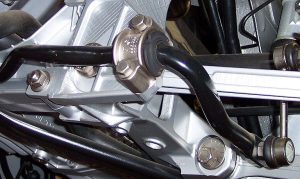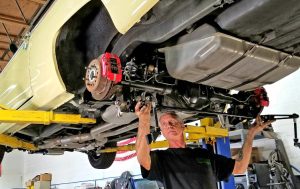In vehicle suspension systems, the stabilizer bar (also known as the anti-roll bar or sway bar) plays a crucial role in controlling body roll during cornering, improving handling stability, and distributing load across a vehicle’s suspension. However, an often underappreciated aspect is where and how the stabilizer bar is mounted — the mounting points (i.e. chassis mounts, bushings, end links) have a direct and influential effect on handling dynamics. In this article we’ll examine how stabilizer bar mounting geometry matters, how it influences vehicle behavior, and what trade-offs engineers and tuners consider when designing or modifying these mounting points.

Fundamentals: How Stabilizer (Anti-Roll) Bars Work
Before diving into mounting points, let’s quickly revisit what a stabilizer bar does:
-
A stabilizer bar is a torsional spring connecting the left and right sides of a suspension.
-
During cornering or lateral load, one wheel moves up (compresses), the opposite wheel tends to move down (extends). This relative motion twists the bar, which resists the rotation and thus resists excess body roll.
-
The total roll stiffness of the vehicle is a combination of the suspension springs’ vertical stiffness and the torsional stiffness of the stabilizer bars.
-
By controlling roll without having to vastly stiffen the vertical springs, engineers can preserve ride comfort while regulating body motion.
However, the efficacy of the stabilizer bar is not just a function of its material, diameter, or shape — the mounting geometry, link lengths, and pivot positions all matter significantly.
Key Mounting Components and Geometry
When considering stabilizer bar mounting, the following components and parameters are critical:
| Component / Parameter | Function / Role | Effect on Tuning & Dynamics |
|---|---|---|
| Chassis mounting bushings / brackets | Hold the bar to the vehicle body or frame | The stiffness and placement of bushings influence bar preload, pivot behavior, and local twist compliance |
| End links (linkage to suspension arm or control arm) | Transmit torsional force from bar to wheel side | Link length, pivot angle, and compliance affect effective lever arm and rate. |
| Anchor point positions (fore/aft, vertical, lateral) | Determines bar arm length and motion geometry | Offsets can change mechanical advantage, preloading, and vertical movement coupling |
| Mounting stiffness / compliance | How rigidly the bar is held relative to chassis | Greater compliance (softer bushings or flexible mounts) can reduce harshness but reduce instantaneous response |
| Preload / initial twist | Any pre-twist or preloading on the bar at static stance | Affects how soon the bar engages under small roll angles |
Let’s break down how these link together in influencing handling dynamics.
How Mounting Point Geometry Affects Handling Behavior
1. Lever Arm Effect & Motion Ratio
The distance between the stabilizer bar’s pivot (bushing) and the end link connection defines an effective lever arm. A longer lever arm at the same bar stiffness yields more torque (resistance) for a given angular displacement; a shorter lever reduces it. Changing where the end links attach (closer or further from pivot) directly alters the bar’s effective roll rate.
Example: If an end link is moved further outwards along the bar arm, the same twist gives more force at the wheel, making the bar “stronger” in effect.
2. End Link Length & Vertical Travel Compatibility
End links must accommodate suspension vertical movement without binding. If the link is too short, as the suspension moves, it can exert undesired preload or bind — effectively loading the bar even in neutral. If too long, leverage is lost; if misaligned, side loads and extra stresses may arise.
One forum discussion put it succinctly:
“Mounting them to the control arm most likely changes the motion ratio significantly and will affect the rate as a result.”
Hence, tuning link length and pivot points is critical, especially when modifying suspension height or geometry.
3. Vertical Offset and Roll Center Effects
The vertical position of the bar relative to the suspension arm attachment changes how vertical travel and roll motions map to torsional load. If the bar is mounted significantly above or below the control arm, you introduce vertical leverage, coupling suspension movement with unintended bar twist.
For example, a bar mounted low relative to the control arm may compress or bind when the wheel moves up or down, even when no lateral loading is present.
4. Compliance and Bushings
The stiffness (or softness) of the bushings at the chassis mounting affects how much the bar shifts or rotates under moderate loads. Softer bushings provide comfort by absorbing minor shocks, but they may dampen the bar’s responsiveness in rapid roll transitions. Rigid or polyurethane bushings offer quicker roll control but may transmit additional noise, harshness, or vibration.
5. Preload / Static Twist
Some setups intentionally preload the bar (i.e. slightly twist it at static stance). This means the bar is already under slight torsion before cornering, making it “active” sooner in small roll angles. However, preload can introduce asymmetric behavior (left vs right), and requires precise mounting to avoid undesirable forces at rest.
Effects on Handling Dynamics
The geometry of stabilizer bar mounting has a network of consequences for vehicle behavior:
-
Body Roll Control: A more effective bar (via longer lever arm or stiffer mounts) reduces body roll, improving cornering stability. However, overdoing it leads to harshness and load transfer issues.
-
Understeer / Oversteer Tuning: Adjusting front vs rear roll stiffness via bar geometry is a classic method to tune understeer/oversteer balance. Increasing front bar leverage shifts balance toward understeer; modifying rear bar geometry can induce oversteer if increased.
-
Load Transfer Distribution: The bar affects how load is shared between wheels during roll. Improper mounting geometry can lead to mismatch in left-right forces, unbalancing grip.
-
Transient Response: During sudden directional changes, a well-mounted bar (rigid mounts, optimized lever arms) helps resist abrupt roll and maintain composure. Compliant or poorly aligned mounts can introduce lag or delay in response.
-
Ride Quality / NVH (Noise, Vibration, Harshness): Oversizing or rigid mounting can inject vibrations or discomfort into the chassis, especially over rough roads. The mounting design must balance performance and usability.
Practical Considerations & Tuning Guidance

When designing or customizing stabilizer bar mounting setups, engineers and tuners should keep in mind:
-
Maintain correct alignment: End links should be nearly vertical at rest, within small angular tolerance, to avoid binding under movement.
-
Choose proper mounting height: Avoid extreme vertical offsets that introduce coupling of vertical motion into roll.
-
Use adjustable end links when possible: To fine-tune preload and effective lever arms as suspension travel changes.
-
Bushing selection is key:
-
Soft bushings: more compliance, smoother ride, slower response
-
Firm bushings: stiffer roll control, sharper response, more NVH
-
-
Trial and tuning: Because interactions are complex, often iterative testing (skidpad, slalom, road) is needed to find optimum geometry.
-
Balance front/rear: Changes to mounting at one axle should be considered relative to the other, to maintain or tune the chassis balance.
A helpful checklist:
-
Are end links binding during full compression or droop?
-
Is there unwanted preload in the bar at static stance?
-
Do the bushings allow free twisting or suffer from excessive deflection?
-
Are mounting brackets rigid and aligned with intended geometry?
-
Is the roll balance between front and rear as desired?
Summary & Recommended Action
The mounting points of a stabilizer bar are not mere hardware support — they critically shape how the bar contributes to handling, roll stiffness, and driver feel. By thoughtfully selecting bushing stiffness, end link geometry, vertical offsets, and preload, one can significantly influence vehicle dynamics while managing trade-offs in comfort and performance.
If you are considering upgrading or tuning your stabilizer components, explore high-quality parts that allow flexibility in mounting geometry. You can
Buy Stabilizer & Components online
to access a range of brackets, bars, linkages, and bushings tailored to diverse vehicle setups.
With careful attention to mounting design and tuning, your stabilizer system can deliver sharper cornering, better balance, and more confidence at the limit — all without compromising everyday drivability.